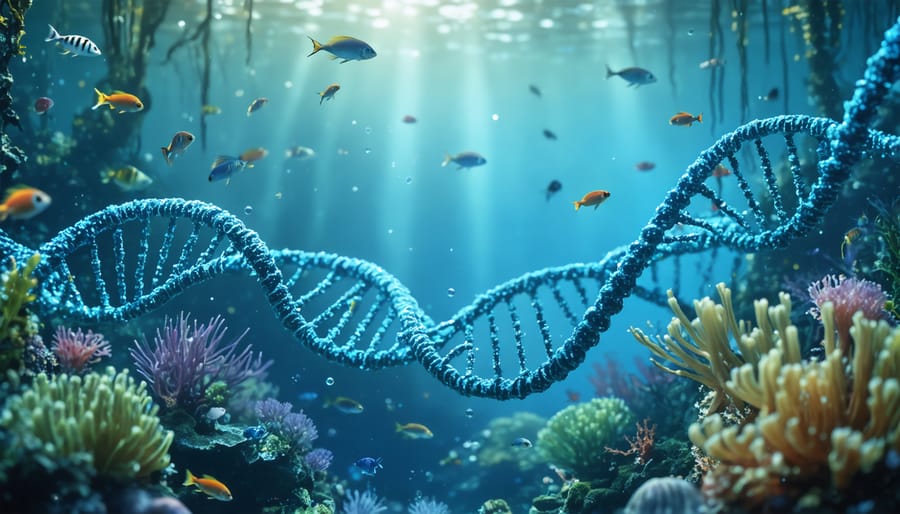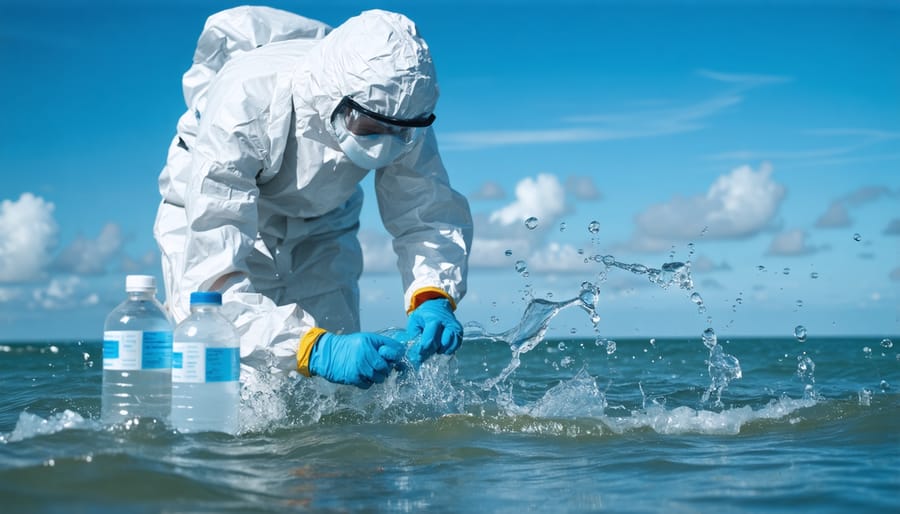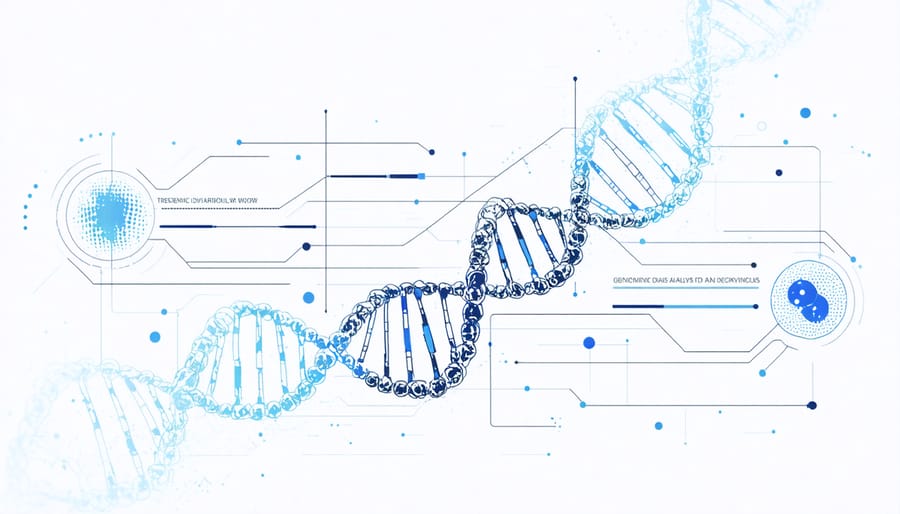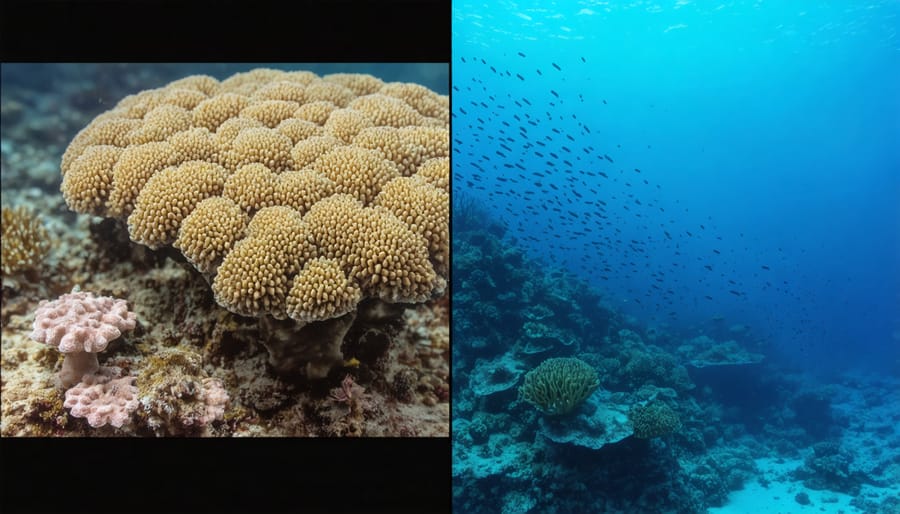
Genomic data analysis has revolutionized our understanding of marine ecosystems, transforming how we approach marine species conservation and biodiversity research. By decoding the genetic blueprints of ocean life, scientists can now track population dynamics, identify threatened species, and uncover complex ecological relationships with unprecedented precision. This powerful tool combines advanced DNA sequencing technologies with sophisticated computational methods, enabling researchers to process millions of genetic markers simultaneously and extract meaningful patterns from vast datasets. From identifying cryptic species to monitoring ecosystem health through environmental DNA (eDNA), genomic analysis has become an indispensable component of modern marine science. As climate change and human activities continue to impact ocean ecosystems, these molecular tools provide crucial insights for developing effective conservation strategies and understanding how marine species adapt to environmental changes. Whether tracking endangered whale populations or discovering new microbial communities in deep-sea environments, genomic data analysis serves as a cornerstone for evidence-based conservation decisions and sustainable ocean management practices.
The Power of Marine Genomic Data Collection
Environmental DNA (eDNA) Sampling
Environmental DNA sampling represents a revolutionary approach to marine biodiversity assessment, allowing scientists to detect and monitor species without direct observation. This non-invasive method involves collecting water samples that contain genetic material shed by organisms through scales, mucus, waste, or other cellular debris.
The process begins with carefully filtering water samples collected from various depths and locations within marine environments. These samples are then processed in laboratories where DNA is extracted, amplified, and sequenced to identify the species present in the ecosystem. This technique can detect everything from microscopic organisms to large marine mammals, providing a comprehensive snapshot of biodiversity.
One of the primary advantages of eDNA sampling is its ability to detect rare or elusive species that might be missed by traditional survey methods. Marine biologist Dr. Sarah Chen notes, “With just a few liters of seawater, we can identify hundreds of species, including those that are typically difficult to observe directly.”
The method is particularly valuable for monitoring invasive species, tracking endangered populations, and assessing ecosystem health over time. Citizen scientists and volunteer groups are increasingly participating in eDNA collection efforts, contributing to large-scale marine conservation projects while learning about marine ecosystems firsthand.

Traditional vs. Modern Sampling Methods
Traditional sampling methods in marine ecosystems typically relied on physical collection techniques like trawling, netting, and visual surveys by divers. While these methods have provided valuable data for decades, they often require extensive field time, can be invasive to marine life, and may miss cryptic or rare species.
Modern genomic sampling approaches have revolutionized how we study marine biodiversity. Environmental DNA (eDNA) sampling allows scientists to collect genetic material directly from seawater samples, detecting organisms that have passed through the area and left behind cellular traces. This method can identify hundreds of species from a single water sample, including those that are typically difficult to observe or catch.
The shift to genomic methods has dramatically improved our ability to monitor marine ecosystems. While traditional methods might require months of fieldwork to survey an area, eDNA sampling can provide comprehensive biodiversity data in a matter of days. Additionally, genomic approaches are less invasive and can detect species at different life stages, from larvae to adults.
However, both methods have their place in marine research. Traditional sampling provides physical specimens and direct observations, while genomic methods offer broader coverage and rapid results. Many researchers now combine both approaches for the most complete understanding of marine ecosystems.
Integration Techniques in Marine Genomics

Data Processing and Analysis Tools
Modern genomic data analysis relies on a sophisticated suite of software tools and platforms designed to handle the complexities of marine genetic information. Popular tools like Galaxy provide user-friendly interfaces for researchers to process and analyze large genomic datasets without extensive programming knowledge.
For sequence alignment and assembly, programs such as BWA (Burrows-Wheeler Aligner) and SPAdes have become standard choices in marine genomics. These tools help scientists piece together genetic fragments and compare them with reference genomes, essential for understanding marine species’ evolutionary relationships.
Data visualization tools like IGV (Integrative Genomics Viewer) and Cytoscape enable researchers to interpret complex genomic data through intuitive graphical representations. These visualizations help identify patterns and relationships that might not be apparent in raw data formats.
For population genetics analysis, programs like Structure and ADMIXTURE help scientists understand genetic diversity and population structures of marine species. Meanwhile, phylogenetic analysis tools such as MEGA and RAxML assist in constructing evolutionary trees and understanding species relationships.
Cloud-based platforms like AWS and Google Cloud are increasingly important for storing and processing massive genomic datasets. These platforms offer scalable computing resources and specialized bioinformatics tools, making it possible to analyze data from large-scale marine genomic studies efficiently.
Quality control tools like FastQC and Trimmomatic ensure the reliability of genomic data, while specialized marine genomics databases provide reference sequences and annotation information crucial for accurate analysis.
Combining Multiple Data Sources
Modern genomic research increasingly relies on integrating multiple data sources to create a more comprehensive understanding of marine ecosystems. By combining genomic data with environmental parameters, such as temperature, salinity, and pH levels, researchers can better understand how marine species adapt to changing conditions and contribute to ocean conservation efforts.
Scientists now routinely merge DNA sequencing data with ecological surveys, satellite imagery, and oceanographic measurements. This integration helps reveal patterns in species distribution, migration routes, and population dynamics that wouldn’t be apparent from genetic information alone. For example, when studying coral reef ecosystems, researchers combine genetic markers with water quality data and temperature records to understand how different coral species respond to environmental stress.
The process typically involves creating specialized databases that can handle diverse data types. Geographic Information Systems (GIS) play a crucial role by providing spatial context to genetic information. Marine biologists use these integrated datasets to track how genetic diversity changes across different ocean regions and environmental gradients.
Real-world applications include monitoring the health of fish populations, where genetic data is combined with catch statistics and ocean current patterns to make informed decisions about sustainable fishing practices. This holistic approach has revolutionized our understanding of marine ecosystems and helps develop more effective conservation strategies.
Real-World Applications and Success Stories
Species Population Monitoring
Genomic data analysis has revolutionized our ability to monitor and track marine species populations with unprecedented accuracy. By analyzing DNA samples collected from seawater, tissue samples, and environmental DNA (eDNA), scientists can now estimate population sizes, track migration patterns, and assess genetic diversity within species groups more effectively than ever before.
This innovative approach allows researchers to detect and monitor marine species interactions and population changes without physically observing or capturing specimens. For example, researchers studying whale populations can analyze eDNA from seawater samples to determine not only the presence of different species but also their approximate numbers and genetic health.
The technology has proven particularly valuable for tracking endangered species and identifying population bottlenecks. Marine biologist Dr. Sarah Chen shares, “We’ve used genomic analysis to discover previously unknown breeding grounds for critically endangered right whales by tracking genetic markers in their population.”
Conservation efforts have been significantly enhanced through this data-driven approach. Scientists can now identify populations at risk of genetic isolation, monitor the success of breeding programs, and make informed decisions about marine protected areas. This information helps conservation teams develop more effective strategies for species protection and habitat preservation, ultimately contributing to the long-term survival of marine ecosystems.
Ecosystem Health Assessment
Genomic data analysis has revolutionized our ability to assess marine ecosystem health by providing unprecedented insights into biodiversity, population dynamics, and species interactions. Through environmental DNA (eDNA) sampling, scientists can now detect the presence of various marine species by analyzing genetic material suspended in seawater, offering a non-invasive method to monitor ecosystem composition.
This cutting-edge approach enables researchers to track changes in species abundance, identify invasive species early, and measure the genetic diversity within populations – a crucial indicator of ecosystem resilience. For instance, in the Great Barrier Reef, genomic analysis has helped scientists monitor coral health and identify populations with enhanced heat resistance, vital information for conservation efforts.
Marine biologist Dr. Sarah Chen explains, “By analyzing genomic data from multiple species simultaneously, we can create a comprehensive picture of ecosystem interactions and health. This helps us identify early warning signs of ecosystem stress before visible changes occur.”
The technology has proven particularly valuable in detecting subtle environmental changes. Regular genomic monitoring can reveal shifts in microbial communities, often the first organisms to respond to environmental stressors like ocean acidification or temperature changes. This early warning system allows conservation teams to implement protective measures before significant ecosystem damage occurs.
Citizen scientists are increasingly contributing to these efforts through organized sampling programs, making ecosystem health assessment a truly collaborative endeavor between scientists and local communities.

Future Directions and Opportunities
The future of genomic data analysis in marine conservation holds tremendous promise, with emerging technologies and methodologies opening new frontiers for research and species protection. Advanced genomic monitoring techniques are becoming more portable and cost-effective, allowing researchers to conduct real-time analysis in the field.
One exciting development is the integration of artificial intelligence and machine learning algorithms with genomic data processing. These tools are becoming increasingly sophisticated at identifying patterns in genetic information, potentially revolutionizing how we track species migration, monitor population health, and detect early warning signs of ecosystem stress.
Miniaturization of sequencing technology is another promising trend. Handheld devices capable of performing DNA analysis are already being tested in marine environments, enabling citizen scientists and local communities to participate in biodiversity monitoring. This democratization of genetic research tools could dramatically expand our understanding of marine ecosystems.
Environmental DNA (eDNA) analysis is expected to become more precise and comprehensive, allowing scientists to detect the presence of multiple species from a single water sample. This advancement could transform how we conduct marine surveys and monitor invasive species, making conservation efforts more efficient and less intrusive.
The integration of genomic data with other environmental metrics, such as temperature, salinity, and chemical composition, will provide a more complete picture of marine ecosystem health. This holistic approach to data analysis will better inform conservation strategies and policy decisions.
Looking ahead, we can expect to see more collaborative international databases sharing genomic information across borders, creating a global network of marine genetic resources. This sharing of data will be crucial for understanding how climate change affects marine species at a genetic level and for developing effective conservation strategies.
The integration of genomic data analysis in marine conservation represents a powerful convergence of technology and environmental stewardship. By unlocking the genetic secrets of marine ecosystems, we gain unprecedented insights into species diversity, population dynamics, and ecosystem health. This knowledge empowers us to make more informed decisions about conservation strategies and resource management.
The impact of genomic data extends far beyond academic research. It provides concrete evidence for establishing marine protected areas, developing sustainable fishing practices, and identifying species at risk. Through these applications, we can better understand and protect the intricate web of life beneath the waves.
However, the success of marine conservation efforts depends on collective action and continued support. Scientists, conservationists, and citizens must work together to collect, analyze, and apply genomic data effectively. There are numerous ways to get involved, from citizen science projects collecting DNA samples to supporting research institutions that conduct genomic studies.
As our oceans face unprecedented challenges from climate change, pollution, and overexploitation, the role of genomic data analysis becomes increasingly crucial. By supporting these initiatives through volunteering, funding, or advocacy, we can contribute to the preservation of marine biodiversity for future generations.
The time to act is now. Whether you’re a scientist, student, or concerned citizen, your participation in marine conservation efforts matters. Together, we can use the power of genomic science to protect and preserve our ocean’s remarkable biodiversity.
jessica
Ava Singh is an environmental writer and marine sustainability advocate with a deep commitment to protecting the world's oceans and coastal communities. With a background in environmental policy and a passion for storytelling, Ava brings complex topics to life through clear, engaging content that educates and empowers readers. At the Marine Biodiversity & Sustainability Learning Center, Ava focuses on sharing impactful stories about community engagement, policy innovations, and conservation strategies. Her writing bridges the gap between science and the public, encouraging people to take part in preserving marine biodiversity. When she’s not writing, Ava collaborates with local initiatives to promote eco-conscious living and sustainable development, ensuring her work makes a difference both on the page and in the real world.
